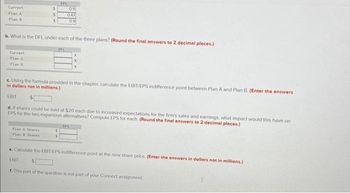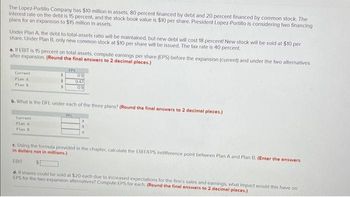
FINANCIAL ACCOUNTING
10th Edition
ISBN: 9781259964947
Author: Libby
Publisher: MCG
expand_more
expand_more
format_list_bulleted
Question
Ss.232.1

Transcribed Image Text:Current
Plan A
Plan B
Current
Plan A
Plan B
$
$
b. What is the DFL under each of the three plans? (Round the final answers to 2 decimal places.)
Plan & Shares
Plan B Shares
EPS
$
09
047
09
DEL
c. Using the formula provided in the chapter, calculate the EBIT/EPS indifference point between Plan A and Plan B. (Enter the answers
in dollars not in millions)
EBIT
d. If shares could be sold at $20 each due to increased expectations for the firm's sales and earnings, what impact would this have on:
EPS for the two expansion alternatives? Compute EPS for each. (Round the final answers to 2 decimal places.)
EPS
e. Calculate the EBIT/EPS indifference point at the new share price. (Enter the answers in dollars not in millions.)
EBIT
S
f. This part of the question is not part of your Connect assignment.

Transcribed Image Text:The Lopez-Portillo Company has $10 million in assets, 80 percent financed by debt and 20 percent financed by common stock. The
interest rate on the debt is 15 percent, and the stock book value is $10 per share. President Lopez-Portillo is considering two financing
plans for an expansion to $15 million in assets.
Under Plan A, the debt-to-total-assets ratio will be maintained, but new debt will cost 18 percent! New stock will be sold at $10 per
share. Under Plan B, only new common stock at $10 per share will be issued. The tax rate is 40 percent.
a. If EBIT is 15 percent on total assets, compute earnings per share (EPS) before the expansion (current) and under the two alternatives
after expansion. (Round the final answers to 2 decimal places.)
Current
Plan A
Plan B
$
$
S
Current
Plan A
Plan B
EPS
b. What is the DFL under each of the three plans? (Round the final answers to 2 decimal places.)
09
047
09
OFL
c. Using the formula provided in the chapter, calculate the EBIT/EPS indifference point between Plan A and Plan B. (Enter the answers
in dollars not in millions.)
$
EBIT
d. If shares could be sold at $20 each due to increased expectations for the firm's sales and earnings, what impact would this have on
EPS for the two expansion alternatives? Compute EPS for each. (Round the final answers to 2 decimal places.)
Expert Solution
This question has been solved!
Explore an expertly crafted, step-by-step solution for a thorough understanding of key concepts.
This is a popular solution
Trending nowThis is a popular solution!
Step by stepSolved in 3 steps

Knowledge Booster
Similar questions
- er 31, 2020 al analysis encil only, ennies blank aper properly. lines asarrow_forwardHansen Corporation. a C Corporation (mot a manufacturer) reports the following items in income and expenses for 2021 Gross Revenue $900,000 Dividend Received from 30% owned Corp 200,000 LTCG 30,000 STCL 12000 City of Lee's Summit Bond Interest 10000 COGS 375000 Administrative Expenses 325000 Charitable Contribution 60,000 Compute Hansen's C Corp Taxable income?arrow_forwardWhat is covered by Regulation S–K?arrow_forward
arrow_back_ios
arrow_forward_ios
Recommended textbooks for you

 AccountingAccountingISBN:9781337272094Author:WARREN, Carl S., Reeve, James M., Duchac, Jonathan E.Publisher:Cengage Learning,
AccountingAccountingISBN:9781337272094Author:WARREN, Carl S., Reeve, James M., Duchac, Jonathan E.Publisher:Cengage Learning, Accounting Information SystemsAccountingISBN:9781337619202Author:Hall, James A.Publisher:Cengage Learning,
Accounting Information SystemsAccountingISBN:9781337619202Author:Hall, James A.Publisher:Cengage Learning, Horngren's Cost Accounting: A Managerial Emphasis...AccountingISBN:9780134475585Author:Srikant M. Datar, Madhav V. RajanPublisher:PEARSON
Horngren's Cost Accounting: A Managerial Emphasis...AccountingISBN:9780134475585Author:Srikant M. Datar, Madhav V. RajanPublisher:PEARSON Intermediate AccountingAccountingISBN:9781259722660Author:J. David Spiceland, Mark W. Nelson, Wayne M ThomasPublisher:McGraw-Hill Education
Intermediate AccountingAccountingISBN:9781259722660Author:J. David Spiceland, Mark W. Nelson, Wayne M ThomasPublisher:McGraw-Hill Education Financial and Managerial AccountingAccountingISBN:9781259726705Author:John J Wild, Ken W. Shaw, Barbara Chiappetta Fundamental Accounting PrinciplesPublisher:McGraw-Hill Education
Financial and Managerial AccountingAccountingISBN:9781259726705Author:John J Wild, Ken W. Shaw, Barbara Chiappetta Fundamental Accounting PrinciplesPublisher:McGraw-Hill Education


Accounting
Accounting
ISBN:9781337272094
Author:WARREN, Carl S., Reeve, James M., Duchac, Jonathan E.
Publisher:Cengage Learning,

Accounting Information Systems
Accounting
ISBN:9781337619202
Author:Hall, James A.
Publisher:Cengage Learning,

Horngren's Cost Accounting: A Managerial Emphasis...
Accounting
ISBN:9780134475585
Author:Srikant M. Datar, Madhav V. Rajan
Publisher:PEARSON

Intermediate Accounting
Accounting
ISBN:9781259722660
Author:J. David Spiceland, Mark W. Nelson, Wayne M Thomas
Publisher:McGraw-Hill Education

Financial and Managerial Accounting
Accounting
ISBN:9781259726705
Author:John J Wild, Ken W. Shaw, Barbara Chiappetta Fundamental Accounting Principles
Publisher:McGraw-Hill Education